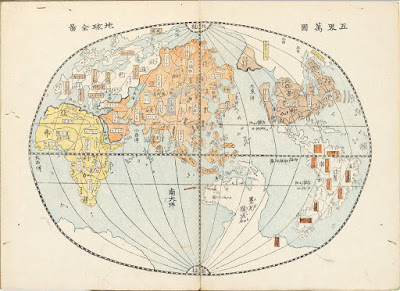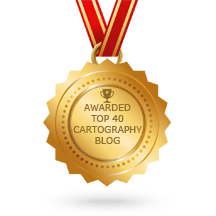Japan is known for a history of resistance to western contact and influence. As a result their knowledge of the rest of the world was slow to develop. The earliest "world" maps produced in Japan were Buddhist maps (nansenbushu) using a combination of geography and mythology.
The map above shows only China, Japan and India [source]. These maps were scaled by religious importance, rather than by distance so the geography is almost unrecognizable. India, the center of the Buddhist world takes up most of the map.
The first nansenbushu to show the entire world was a 1710 woodblock print by monk Rokashi Hotan.
While still dominated by those three countries, this map shows various European countries as islands such as Holland (country of the red hair). Africa (Land of Western Women) and South America are shown as small islands while a piece of North America is connected to Asia by an Aleutian land bridge. By this time many western world maps had filtered into the country but these influences were either missed or were ignored by Hotan. Here is detailed look- the entire map can be browsed here.
Matteo Ricci was a missionary who learned Chinese and made a map of the world in the Chinese language, readable to some Japanese. This influenced the Bankoku-sozu map, the first western style world map created in Japan. The version below is centered on Japan, oriented with east up and contains pictures of various ethnic groups.
The image above is a screen shot from The Evolution of Japanese Cartography by Olivia McCaffrey.
Nagakubo Sekisui, considered the founder of Japanese geography, made the above world map largely based on Ricci's map in 1785. Each continent has its own color while the unexplored Antarctica has a bold red outline. Here's a detail showing Japan (in the center of the world) and Korea.
Here is North America. California is shown as a peninsula because this map predates the theory of it being an island.
The entire map can be browsed at Barry Lawrence Ruderman Antique Maps, Inc, along with some interesting historical details. For example, Nagakubo's omitted ridiculous, prejudicial notes from the Ricci map about Japan while keeping similar notes about other places such as Brazil. "The inhabitants of this country do not build houses. They dig the earth and live in caverns. They like to eat human flesh, however they only eat men and not women. Their clothes are made from birds feathers."
An 1834 map by Giko Yamazaki drawn as a sphere - via the Ephemera Assemblyman blog - this page contains many other maps from this era. California has now gained its status as an island.
Here is a map by an unknown cartographer via All That is Interesting from 1853, just when Japan was being forced to open itself up to foreign trade. The geography is improving noticeably.
Finally, a Japanese World Map circa 1933 by mangaka (cartoon artist) Keizo Shimada.
The "cultural vignettes" are mostly benign, if a bit stereotypical, but the map also gives a sense of Japan's imperial and military ambitions. Some detailed views-via eBay.
Here is Washington and British Columbia.
The map above shows only China, Japan and India [source]. These maps were scaled by religious importance, rather than by distance so the geography is almost unrecognizable. India, the center of the Buddhist world takes up most of the map.
The first nansenbushu to show the entire world was a 1710 woodblock print by monk Rokashi Hotan.
While still dominated by those three countries, this map shows various European countries as islands such as Holland (country of the red hair). Africa (Land of Western Women) and South America are shown as small islands while a piece of North America is connected to Asia by an Aleutian land bridge. By this time many western world maps had filtered into the country but these influences were either missed or were ignored by Hotan. Here is detailed look- the entire map can be browsed here.
Matteo Ricci was a missionary who learned Chinese and made a map of the world in the Chinese language, readable to some Japanese. This influenced the Bankoku-sozu map, the first western style world map created in Japan. The version below is centered on Japan, oriented with east up and contains pictures of various ethnic groups.
The image above is a screen shot from The Evolution of Japanese Cartography by Olivia McCaffrey.
Nagakubo Sekisui, considered the founder of Japanese geography, made the above world map largely based on Ricci's map in 1785. Each continent has its own color while the unexplored Antarctica has a bold red outline. Here's a detail showing Japan (in the center of the world) and Korea.
Here is North America. California is shown as a peninsula because this map predates the theory of it being an island.
The entire map can be browsed at Barry Lawrence Ruderman Antique Maps, Inc, along with some interesting historical details. For example, Nagakubo's omitted ridiculous, prejudicial notes from the Ricci map about Japan while keeping similar notes about other places such as Brazil. "The inhabitants of this country do not build houses. They dig the earth and live in caverns. They like to eat human flesh, however they only eat men and not women. Their clothes are made from birds feathers."
An 1834 map by Giko Yamazaki drawn as a sphere - via the Ephemera Assemblyman blog - this page contains many other maps from this era. California has now gained its status as an island.
Here is a map by an unknown cartographer via All That is Interesting from 1853, just when Japan was being forced to open itself up to foreign trade. The geography is improving noticeably.
Finally, a Japanese World Map circa 1933 by mangaka (cartoon artist) Keizo Shimada.
The "cultural vignettes" are mostly benign, if a bit stereotypical, but the map also gives a sense of Japan's imperial and military ambitions. Some detailed views-via eBay.
Here is Washington and British Columbia.














No comments:
Post a Comment